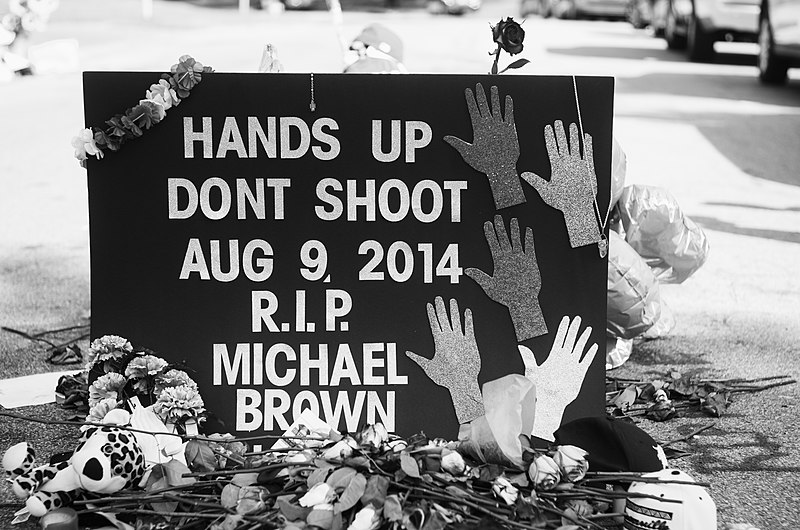 |
| © Jorge Royan / http://www.royan.com.ar / |
The proverbial light bulb comes on.
I have an idea!
I am thinking... and like a flash, a new thought enters my mind and erupts in an explosion, a mental rush of energy and activity.
For me. and maybe you, too, this most often happens at night just when I am drifting off, not yet asleep but not truly still awake-- or when I am beginning to wake, yet still floating on a sea of thoughts and images. It begins in the back of my mind-- an inkling-- a burst, or on that rare occasion, fireworks and a full-blown idea, complete and ready to air and share.
Maybe it is an idea for writing something that has been poking at me for days or even months.
That happened the other night. I have been wanting to write more about Ferguson and the police and racism and all that is going on right now. As I lay in bed it occurred to me to combine my love of short and formal forms ( haiku, haibun, ghazal, pantoum) along with some free form structures to create a repetitive, multilayered piece....in which the same ideas get turned over and over to show each facet of the ugly crystal from which we can't take our eyes away.
Click here to read a draft of this piece, Ferguson: A Nightmare-- No Matter What (Form), which is still under construction.
Maybe it is an idea for how to accomplish something in a situation that is unusual in some way.
I will be working this afternoon with teachers in a local school district for their early release session. I have been pondering how to share the mentor texts I will be using for the session with this large number of folks--about 100 teachers. In smaller groups, I usually pass the books around so the everyone can touch and see. Late last night in a flash it occurred to me to put two or three books on each table. A compromise of sorts.
What do you do with an idea?

 Kobi Yamada helps us thing about this question in his new book What Do You Do With an Idea?
Kobi Yamada helps us thing about this question in his new book What Do You Do With an Idea?
This is the question the little boy in this story faces:
He goes on to share how "strange and fragile" the idea was and wasn't quite sure what to do with is.
His idea is pictured as a small egg-like creature with legs and a crown. The idea gets bigger and more important, is fed by the boy, and receives various responses from his friends and other people.
Some discouraged his idea, but the boy continues to work with his idea.
In the end, he learns that not only can an idea grow, but when it is shared, when it bursts forth and flies, one idea can change the world.
What idea have you been feeding and growing that might make a difference in your home, community or the larger world?
What idea is following you?
Like the old riddle, Which comes first the chicken or the egg? we may wonder which comes first-- the idea or the need for the idea.
 In Yamada's story, the idea comes first and his main character must determine how to use the idea.
In Yamada's story, the idea comes first and his main character must determine how to use the idea.
 But sometimes we, instead, encounter a situation in which we desperately need an idea.
But sometimes we, instead, encounter a situation in which we desperately need an idea.
The old saying goes, Necessity is the mother of invention.
In The Flat Rabbit by Bardur Oskarsson, a dog and a cat are in this difficult spot. They have come across a flat rabbit, a dead rabbit, lying in the road.
by Bardur Oskarsson, a dog and a cat are in this difficult spot. They have come across a flat rabbit, a dead rabbit, lying in the road.
What must they do? They need an idea.
They brainstorm idea after idea, seeking a suitable way to honor the rabbit and a fitting sending-off.
And so their thinking and ideas continued...
Students will love following the thinking of the dog and rat, as well as matching it with their own ideas.
What else could Cat and Rat have done with the flat rabbit?
What do you do with an idea?
Where do we find ideas?
Write an essay on the process of developing new ideas.
Write a poem tracing the birth and growth of your latest idea.
For me. and maybe you, too, this most often happens at night just when I am drifting off, not yet asleep but not truly still awake-- or when I am beginning to wake, yet still floating on a sea of thoughts and images. It begins in the back of my mind-- an inkling-- a burst, or on that rare occasion, fireworks and a full-blown idea, complete and ready to air and share.
Maybe it is an idea for writing something that has been poking at me for days or even months.
That happened the other night. I have been wanting to write more about Ferguson and the police and racism and all that is going on right now. As I lay in bed it occurred to me to combine my love of short and formal forms ( haiku, haibun, ghazal, pantoum) along with some free form structures to create a repetitive, multilayered piece....in which the same ideas get turned over and over to show each facet of the ugly crystal from which we can't take our eyes away.
Click here to read a draft of this piece, Ferguson: A Nightmare-- No Matter What (Form), which is still under construction.
Maybe it is an idea for how to accomplish something in a situation that is unusual in some way.
I will be working this afternoon with teachers in a local school district for their early release session. I have been pondering how to share the mentor texts I will be using for the session with this large number of folks--about 100 teachers. In smaller groups, I usually pass the books around so the everyone can touch and see. Late last night in a flash it occurred to me to put two or three books on each table. A compromise of sorts.
What do you do with an idea?

This is the question the little boy in this story faces:
One day I had an idea.
"Where did it come from ? Why is it here?"
I wondered, "What do you do with an idea?"
He goes on to share how "strange and fragile" the idea was and wasn't quite sure what to do with is.
His idea is pictured as a small egg-like creature with legs and a crown. The idea gets bigger and more important, is fed by the boy, and receives various responses from his friends and other people.
Some discouraged his idea, but the boy continues to work with his idea.
In the end, he learns that not only can an idea grow, but when it is shared, when it bursts forth and flies, one idea can change the world.
What idea have you been feeding and growing that might make a difference in your home, community or the larger world?
What idea is following you?
Like the old riddle, Which comes first the chicken or the egg? we may wonder which comes first-- the idea or the need for the idea.
 In Yamada's story, the idea comes first and his main character must determine how to use the idea.
In Yamada's story, the idea comes first and his main character must determine how to use the idea.The old saying goes, Necessity is the mother of invention.
In The Flat Rabbit
What must they do? They need an idea.
They brainstorm idea after idea, seeking a suitable way to honor the rabbit and a fitting sending-off.
They went to the park to think.
At least the dog was thinking--so hard that his brain was creaking.
Where could they move her? And what if somebody found her and ate her?
They could leave her outside number 34, but what would people there think if they saw a dog and a rat bringing back their rabbit, totally flattened? No good would come of that.
And so their thinking and ideas continued...
Students will love following the thinking of the dog and rat, as well as matching it with their own ideas.
What else could Cat and Rat have done with the flat rabbit?
What do you do with an idea?
Where do we find ideas?
Today's Deeper Writing Possibilities
Reflect on how you develop new ideas.
When was the last time you got a great new idea?
Where were you? How did it occur to you?
How did you feed and grow your idea? With whom did you share it?
What were the reactions and respsonses of others to your idea?
What were the reactions and respsonses of others to your idea?
Write an essay on the process of developing new ideas.
Write a poem tracing the birth and growth of your latest idea.


























